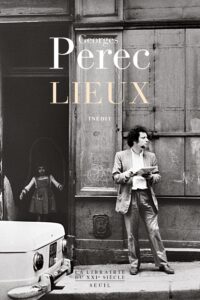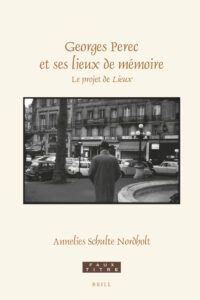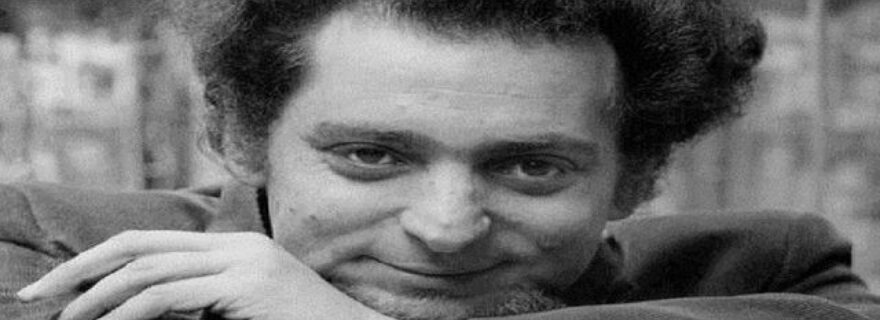Georges Perec and his Sites of Memory
Lieux, by the 20th-century French author Georges Perec, is an experimental collection of texts and photographs describing the author’s sites of memory. In this blog, Annelies Schulte Nordholt introduces you to Perec’s and to her own book Georges Perec et ses lieux de mémoire (Brill, Leiden, 2022).
“I would like there to exist places that are stable, unmoving, intangible, untouched and almost untouchable, unchanging, deep-rooted; places that might be points of reference, of departure, of origin: my birthplace, the cradle of my family, the house where I may have been born […] Such places don’t exist, and it’s because they don’t exist that space becomes a question, ceases to be self-evident […] It’s never mine, never given to me, I have to conquer it.” (Perec 2008, 91)
These words conclude Species of Spaces, Perec’s highly original essay on space. Georges Perec, born in Paris in 1936 from a Polish-Jewish family, survived World War II in hiding in the French Alps. His father perished as a soldier in 1940, his mother was killed in Auschwitz. The war bereaved him not only of his parents but also of his early childhood memories. It erased his memories of people but also of places, for instance the Rue Vilin, the tiny street in the north of Paris where he had lived for the first six years of his life. These biographical facts are at the root of his need to question space in his writing.
The question of space is prominently present in both his novels and his essays. His most famous novel, Life. A User’s manual (1978), focuses on a Paris flat, describing its 99 apartments: who lives there and what happens there? Many of these stories – about collectors, artisans, forgers and even murderers - are indirectly told through the meticulous description of interiors (furniture, pictures on the wall…). The same goes for Perec’s numerous essays, some of which bear similar titles: “The Scene of a Flight” (“Les lieux d’une fugue”, 2008), “The Scene of a Stratagem” (“Les lieux d’une ruse”, 2008). The former is about the long day Perec spent as a twelve-year old boy on the Square Franklin-Roosevelt, when he had fled home. The latter is about his psychoanalysis in the seventies. The texts do not offer a narrative but a detailed description of the places where they happened, as if space were the only detour through which one may speak about oneself or about the world.
But there is one work where places become the central subject-matter: it is his experimental project called Lieux, created during the first half of the seventies. Lieux is set up according to an algorithm, in line with Oulipo, the group of experimental writers and mathematicians that Perec was a member of. For it, he selected twelve Paris sites for which he had a strong personal attachment, such as the Rue Vilin, where he spent his pre-war years, or the Place d’Italie, where he typed his first novel. The project was meant to describe these twelve places over a period of twelve years, writing two texts a month. The texts are of two different types: one is a factual description of a place, made on the spot (a Réel), the other is a series of memories about a place (a Souvenir). The algorithm determined the order of the texts, distributing them in such a way that every month, a different pair of sites was described. Although Perec stopped working on Lieux after five years, the present state of the project includes a huge number of texts, photographs, personal documents and ephemera collected from the streets.

When I started working on the corpus, the texts had not yet been published nor had they been transcribed. This made it an adventurous enterprise. Last spring, Lieux
was finally published by Editions du Seuil, in an exemplary edition, both paper and online (Sommaire | Lieux - Georges Perec (seuil.com)).
A central question of my own book is: what is the genre of Lieux? Earlier commentators considered it either as the work of an Oulipo adept or as an autobiographical work. Others saw it as the work of a sociologist of daily life and some underlined its link to the art of memory, a part of classical rhetoric. Lieux is all of these, obviously, but to my view, classical rhetoric allows us to tie together these different dimensions. “My only tradition, my only memory, my only site [lieu] is rhetorical : a sign of encrage […]”, Perec wrote in one of his memories of the Rue Vilin (2022, 187-188). In other words, his memory cannot be rooted in a stable place but only in writing, in language. This is made clear by the neologism encrage, a wordplay on ancrage (anchorage): Perec’s memory has no spatial anchorage, it only ‘anchors’ in ink (encre), i.e. in writing.
But what is the meaning of the term “rhetorical sites” here? It is a reference to classical rhetoric, the universally acknowledged method for writing speeches and texts throughout Greek and Roman Antiquity, up to the Renaissance. Classical rhetoric inspired Perec especially in its part called Inventio, the art of finding something to say on a particular subject. The Latin word does not refer to the invention of something new but to the finding of what already exists in our cultural patrimony. Now this patrimony is made of common places (topoi or
loci communes): in rhetoric, these are not cheap clichés but a rich reservoir of material at our disposal. Every subject has its topics and Perec’s Lieux
texts are often constructed as topics of his Paris sites, mapping their present or past state, i.e. inventorying his memories of persons and micro-events related to that particular site. That is how they become sites of memory. We should not take this term in the sense of Pierre Nora’s famous sites of (French) national memory. Perec’s sites of memory are personal in the first place. But their sociological description makes them into places of collective memory. The subsequent descriptions of Paris streets and squares create a portrayal of a collective, generational memory of public space. Perec’s sites are certainly physical places but they only exist and survive through writing, which makes rhetorical sites of them.

At the end of Species of spaces, Perec puts it in the following way: “To write: to try meticulously to retain something, to cause something to survive; to wrest a few precise scraps from the void as it grows, to leave somewhere a furrow, a trace, a mark or a few signs” (2008, 92). This is an accurate description of his work in Lieux and maybe also of my own attempt to fathom his project. Published only a few months after Lieux itself, Georges Perec et ses lieux de mémoire is the first book-length study about this vast and fascinating body of work. It explores its recurrent themes, writing practises, graphisms and photographs, showing the impact of classical rhetoric on Perec’s methodology.
References
Perec, Georges. Species of Spaces and Other Pieces. Translated by John Sturrock. Penguin Classics, 2008.
Perec, Georges. Lieux. Paris: Editions du Seuil, Collection La Librairie du XXIe siècle, 2022.
Schulte Nordholt, Annelies. Georges Perec et ses lieux de mémoire. Le projet de Lieux. Leiden: Brill, « Faux Titre », 2022.
© Annelies Schulte Nordholt and Leiden Arts in Society Blog, 2022. Unauthorised use and/or duplication of this material without express and written permission from this site’s author and/or owner is strictly prohibited. Excerpts and links may be used, provided that full and clear credit is given to Annelies Schulte Nordholt and Leiden Arts in Society Blog with appropriate and specific direction to the original content.



0 Comments